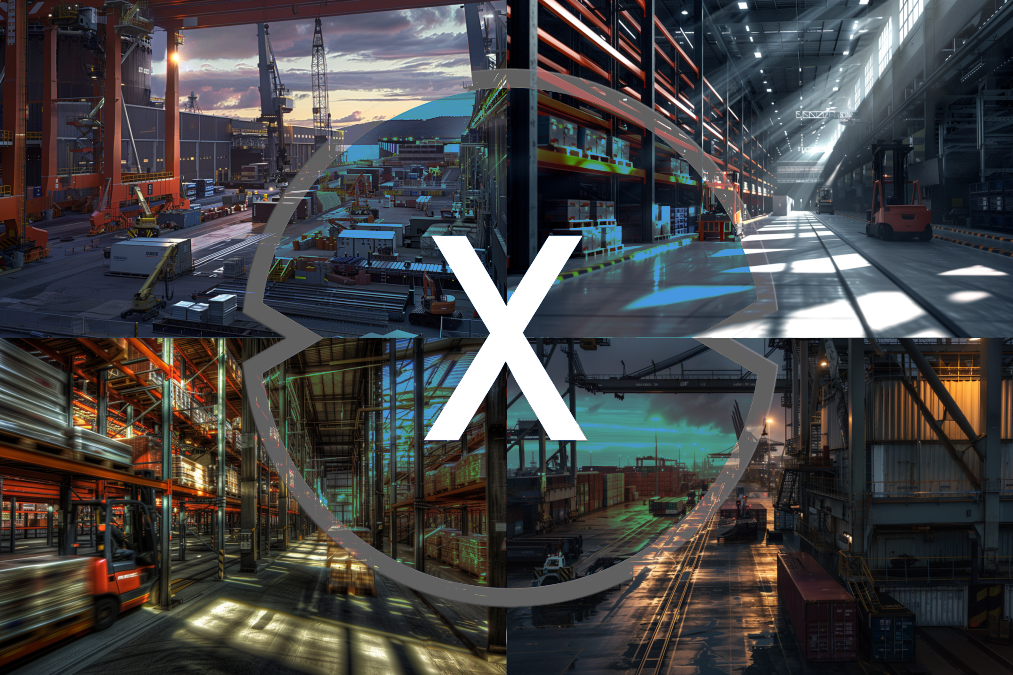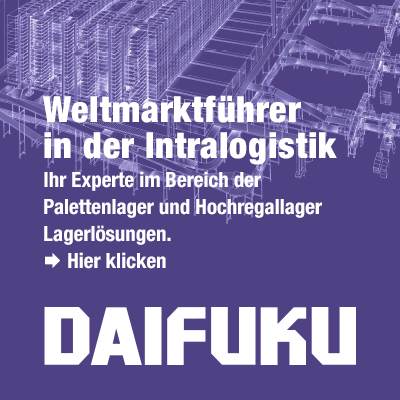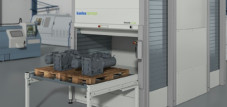Nearshoring vs. offshoring warehouse processes: The importance of buffer warehouses for flexible production processes
Language selection 📢
Published on: October 22, 2024 / update from: October 28, 2024 - Author: Konrad Wolfenstein

Nearshoring vs. Offshoring: The importance of buffer storage for flexible production processes – Image: Xpert.Digital
🚀 Increasing efficiency through nearshoring and offshoring: The key role of buffer warehouses
🎯 In today's globalized economy, companies are faced with the constant challenge of making their production processes efficient, cost-effective and flexible at the same time. Two strategies that are often used here are nearshoring and offshoring. While both approaches aim to achieve competitive advantage through relocation, they differ significantly in terms of supply chain management, cost structures and flexibility. An often underestimated but crucial factor in this context is the role of buffer storage. This article highlights the differences between nearshoring and offshoring and shows how buffer storage can significantly influence the flexibility and efficiency of production processes.
☀️ What do offshoring and nearshoring mean?
Offshoring
refers to the relocation of business processes or production facilities to distant countries, usually in order to benefit from lower wages and operating costs. Typical destinations for offshoring are Asian countries such as China, India or Vietnam, which are attractive due to their low-cost workforce and growing industrial expertise.
Nearshoring
On the other hand, this means relocating these processes to countries that are geographically closer. For European companies, these could be Eastern European countries such as Poland or the Czech Republic, but also North African countries such as Morocco or Tunisia. The main advantage of nearshoring is the physical proximity, which enables shorter delivery times and easier communication.
🌟 Advantages and disadvantages of offshoring
Advantages of offshoring
Cost efficiency
Lower labor and operating costs are the main incentive for offshoring. Companies can significantly reduce their production costs.
Scalability
Access to large labor pools enables flexible scaling of production.
Market presence
Offshoring offers the opportunity to open up new markets and strengthen your global presence.
Disadvantages of offshoring
Long delivery times and higher transport costs
The large geographical distance leads to extended delivery times and increased logistics costs.
Communication and cultural barriers
Different time zones, language barriers and cultural differences can make collaboration difficult.
Risk factors
Political instability, currency risks and different legal frameworks may pose additional risks.
Quality control
Monitoring and ensuring quality standards is more demanding over long distances.
🌍 Advantages and disadvantages of nearshoring
Advantages of nearshoring
Geographic proximity
Shorter transport routes not only reduce delivery times, but also transport costs.
Similar time zones and cultural affinities
This makes communication easier and promotes more effective collaboration.
Greater flexibility
Faster reaction times to market changes and customer needs are possible.
Improved quality control
The proximity allows for more frequent visits and closer monitoring of production processes.
Disadvantages of nearshoring
Lower cost savings
Wage and operating costs are often higher than in typical offshoring countries, which limits the savings potential.
Limited access to resources
Not all nearshoring countries have the same resources or skilled workers as established offshoring destinations.
Infrastructure differences
The industrial infrastructure can vary and is not always at the level of offshoring locations.
🏭 The role of buffer storage in production processes
Buffer stock, also known as safety stock, is additional inventory that companies hold to mitigate fluctuations in supply and demand or disruptions in the supply chain. They are a crucial factor for the flexibility and reliability of production processes and can reduce the risks of long or complex supply chains.
Buffer storage in an offshoring context
With offshoring strategies, supply chains are longer and more complex. Delays due to transport, customs clearance or unforeseen events can significantly affect delivery times. Buffer stocks help to compensate for these uncertainties by maintaining an inventory that ensures production continuity. However, larger buffer stocks lead to increased storage costs and tie up capital.
Buffer storage in a nearshoring context
Although the supply chains with nearshoring are shorter and less complex, buffer storage also plays an important role here. They enable companies to react quickly to fluctuations in demand and increase production flexibility. However, the shorter distance often allows smaller buffer warehouses, which leads to cost savings.
⚙️ Why are buffer warehouses important for flexible production processes?
1. Reduction of delivery times
By maintaining inventory, products can reach customers more quickly, which increases customer satisfaction.
2. Balancing fluctuations in demand
Buffer storage makes it possible to meet sudden increases in demand without having to immediately adjust production.
3. Minimize production interruptions
In the event of disruptions in the supply chain, buffer stocks can maintain production and avoid delivery disruptions.
4. Increasing competitiveness
Flexibility in production and delivery ability can represent a decisive competitive advantage.
🛠️ Strategic considerations for warehousing
The decision about the size and need for buffer storage depends on several factors:
Risk management
Companies need to assess the potential risks in their supply chain and plan accordingly.
Cost-benefit analysis
The costs of warehousing must be weighed against the benefits of increased flexibility and security of supply.
Market dynamics
In volatile markets, larger buffer stocks can make sense in order to be able to react to rapid changes.
Production strategy
Approaches such as just-in-time (JIT) or lean manufacturing aim to minimize inventory levels, but require extremely reliable supply chains.
🤖 Technological influences and modern approaches
Digitalization and new technologies are having a significant impact on supply chain and inventory management:
Just in Time (JIT)
This approach aims to minimize inventory by delivering materials exactly when they are needed. This reduces storage costs but increases the dependency on a smooth supply chain.
Predictive Analytics
By analyzing data, companies can improve demand forecasts and optimize their inventory levels.
Automation and IoT
Automated warehouse systems and the use of the Internet of Things enable more efficient warehouse management and reduce human errors.
🌱 Sustainability aspects
The choice between nearshoring and offshoring also has ecological implications:
Transport emissions
Longer transport routes during offshoring lead to higher CO₂ emissions. Nearshoring can reduce environmental impact through shorter transport routes.
Sustainable supply chains
Companies are under increasing pressure to make their supply chains more sustainable. The reduction of inventories and more efficient logistics processes contribute to this.
💼 Practical examples and case studies
Many companies have recognized the advantages of nearshoring in combination with optimized buffer storage:
Automotive industry
A German automobile manufacturer moved parts of its production to Eastern Europe. Geographical proximity enabled delivery times to be reduced by 50% and inventory levels to be reduced by 30%.
Electronics industry
An electronics company used nearshoring to respond more quickly to technological developments and shorten time-to-market.
📈 Challenges and solutions
Despite the advantages, there are also challenges that must be overcome:
Initial investments
Changing production and supply chains requires investments in infrastructure and technology.
Shortage of skilled workers
There may be a shortage of specialized workers in nearshoring countries. Local training and development are therefore crucial.
Legal framework
Different legal requirements can make the implementation of nearshoring strategies more difficult.
Solutions:
Enter into partnerships
Working with local companies can make it easier to get started and reduce cultural and legal hurdles.
Investment in training
Training programs can be used to develop the required specialists on site.
Flexible supply chain management
The use of technology and data analysis enables agile adaptation to market conditions.
🎯 Nearshoring or offshoring?
The decision between nearshoring and offshoring is complex and depends on individual company goals, market conditions and risk tolerance. In both scenarios, buffer storage plays a crucial role in smoothing out fluctuations in the supply chain. When it comes to nearshoring, buffer warehouses can help shorten response times to market demands and minimize delivery bottlenecks through flexible storage. At the same time, they enable better inventory control and reduce transport costs through shorter distances.
In the offshoring context, buffer warehouses help to mitigate longer delivery times and possible delays in international transport. They offer an additional security buffer to cushion risks that can arise from geopolitical tensions or complex customs procedures. In both cases, proper sizing and management of buffer storage is critical to achieving efficiency and cost optimization.
📣 Similar topics
- 🚀 Effective strategies in the globalized economy
- 🌍 Nearshoring vs. Offshoring: A comparison
- 🏢 The role of buffer bearings in production
- 📦 Why buffer storage is crucial
- 🔄 Strategies for flexible warehousing
- 💡 Technology and modern storage approaches
- 🌿 Sustainability in the supply chain
- 🚗 Nearshoring success stories in the industry
- 🚧 Challenges and solutions in nearshoring
- 💼 Decision factors for nearshoring and offshoring
#️⃣ Hashtags: #Nearshoring #Offshoring #Bufferstock #Flexibility #Sustainability
Xpert partner in warehouse planning and construction
We are there for you - advice - planning - implementation - project management
☑️ Smart City & Factory: Industry expert for energetic 5G buildings and halls as well as advice and installation of solar systems
☑️ Xpert.Plus - logistics consulting and logistics optimization
☑️ Industry expert, here with his own Xpert.Digital Industry Hub with over 2,500 specialist articles
I would be happy to serve as your personal advisor.
You can contact me by filling out the contact form below or simply call me on +49 89 89 674 804 (Munich) .
I'm looking forward to our joint project.
Xpert.Digital - Konrad Wolfenstein
Xpert.Digital is a hub for industry with a focus on digitalization, mechanical engineering, logistics/intralogistics and photovoltaics.
With our 360° business development solution, we support well-known companies from new business to after sales.
Market intelligence, smarketing, marketing automation, content development, PR, mail campaigns, personalized social media and lead nurturing are part of our digital tools.
You can find out more at: www.xpert.digital - www.xpert.solar - www.xpert.plus


























